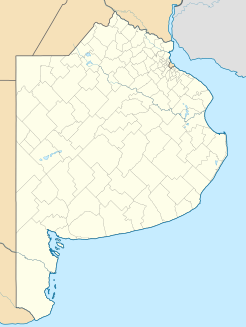Isla Martín García
| Isla Martín García | ||
|---|---|---|
| Satellite image of the island of Martín García | ||
| Waters | Río de la Plata | |
| Geographical location | 34 ° 10 '47 " S , 58 ° 15' 0" W | |
|
|
||
| length | 1.8 km | |
| width | 1.4 km | |
| surface | 1.84 km² | |
| Residents | 200 (2001) 109 inhabitants / km² |
|
The Martín García Island is one of two enclaves of Argentina . The small island lies in Uruguayan territorial waters in the Río de la Plata and is at 34 ° 10 'south latitude and 58 ° 15' west longitude. Just a few meters to the north is the small Isla Timoteo Domínguez and southwest of that the even smaller Islote Hércules , both of which already belong to Uruguay.
According to INDEC, the island had fewer than 200 inhabitants (approx. 50 families) in 2001 .
geography
The island is a small formation of ancient rocks of the Brasilia massif with an area of 184 hectares, which is surrounded by sedimentary rocks washed up by the Río de la Plata. Isla Solís , which also belongs to Argentina and consists only of sediments, is 6 km to the southwest . As the process of gradual enlargement is in progress, it is assumed that, geologically speaking, the island will integrate into the delta of the Río Paraná for a relatively short time .
Political
Administratively, the island belongs to the province of Buenos Aires and is governed directly by the provincial government, it legally belongs to the Partido La Plata . The Dirección de las Islas of the government ministry of the province is responsible for the administration and the agriculture ministry is responsible for the protection of flora and fauna.
history
The island was first sighted - from a European point of view - by the expedition of the navigator Juan Díaz de Solís in 1516 . One of the members of the expedition by the name of Martín García died in the vicinity of the island, his body was left there and the island was named after him.
Due to its strategic location near the confluence of the Río Uruguay in the Río de la Plata, the island was soon the object of disputes between the Spaniards and the Portuguese. From 1765 the island was used as a prison and place of exile. When the viceroyalty of the Río de la Plata was founded, the first viceroy Pedro de Cevallos built a military fortress. Both during the Argentine War of Independence (1810-1818) and during the Argentine-Brazilian War , it was the scene of battles. During the second reign of the dictator Juan Manuel de Rosas , it was also attacked by Anglo-French troops.
In the second half of the 19th century, a proposal by the author and later President of Argentina, Domingo Faustino Sarmiento , from 1850 to found the city of Argirópolis on the island , should become the capital of an Argentina united with Uruguay, is worth mentioning . During this time, many of the Indian chiefs captured in the course of the so-called desert campaign at the end of the 1870s were banished to the island. In 1900 there was already a police headquarters and a hospital as well as artillery batteries on the island, stones were also mined on the island as building material for Buenos Aires ,
Between 1900 and 1970 the island became known as the place of exile for numerous important politicians, among them the presidents Hipólito Yrigoyen (1930), Juan Perón (1945) and Arturo Frondizi (1962).
In 1973 Argentina signed the Río de la Plata Treaty with Uruguay , in which the eastern neighboring country bindingly recognized Argentina's sovereignty over the island of Martín García, but Argentina had to recognize another island Juncal and parts of the waters of the Río de la Plata Uruguay cede, whereby the island completely surrounded by Uruguayan territorial waters became an exclave . However, the distance to the Argentine part of the Río de la Plata is less than 2 km.
Economy and tourism
Today the island is primarily a tourist destination . The old "Chinese Quarter", the ruins of the military fortresses, the military hospital and the presidium, as well as a natural marshland are worth seeing. Pan dulce , an Argentine cake, is also produced in small quantities on the island .
Web links
swell
- ↑ The book Argirópolis ( Memento of the original from March 4, 2016 in the Internet Archive ) Info: The archive link was inserted automatically and has not yet been checked. Please check the original and archive link according to the instructions and then remove this notice. (PDF file; 403 kB)


